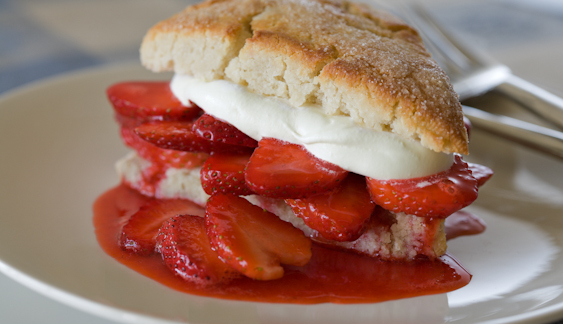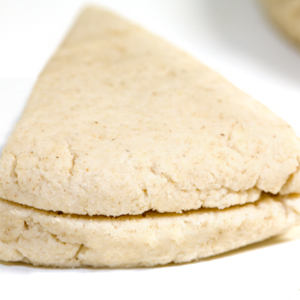Rice Shortcake with Strawberries

introduction
Have you heard the one about the chef who makes a mistake, suffers excoriation, and ends up with an unimaginably delicious dish? Like a fallen soufflé that becomes a molten chocolate cake? Well, this is precisely what happened when Anson Mills’ chief cook and bottle washer, Kay Rentschler, retested a biscuit recipe using the wrong flour. Instead of producing quick cream biscuits made with wheat biscuit flour, she produced quick cream biscuits using Anson Mills Carolina Rice Flour. Like others before her, she, too, was excoriated: rice flour doesn’t feel like wheat flour—it should have been obvious.
Nevertheless, there was something about these biscuits. For one thing, they actually baked up into perfectly recognizable biscuits. (Rice flour is rarely, if ever, used without some wheat flour in baking recipes because it produces no gluten—the sturdy protein that results when water is mixed with wheat flour). But not only did these biscuits look like good biscuits—bronze-edged and craggy on the surface, creamy white inside—they were the lightest, crispest, most tender biscuits ever. They were biscuits that said “Shortcake!”
After a couple of tweaks to the recipe—butter and milk in place of cream, an improved wedge shape for easy cutting, a shower of sugar granules on top—and we had the best damned shortcake biscuits we know of. What are they like? Imagine a crisp, delicate sugar cookie, dial back the sweetness, loft it into biscuit form, and you’re about as close to these ethereal biscuits as you’re going to get until you make some yourself.
Baking Notes
Because these biscuits are made with rice flour, the dough will feel different. Don’t expect any of the light elasticity of a wheat dough—the subtle drag you feel when you push a biscuit cutter through a regular biscuit dough that signals some gluten development. The dough will also feel wetter. Don’t worry: you don’t have to do much with it beyond pressing it into a disk and cutting it into wedges. Treat it gently.
Let us not forget the strawberries. The ultimate strawberries are small, sweet, deep red, juicy, and local. Of course, local berries aren’t always easy to find: strawberries don’t grow on trees, and their season is brief. But a summer dessert as iconic as this needs the best berries you can find. At
the very, least strawberries should smell like strawberries—even those
big, hulking California-grown berries can be forgiven if they’re fragrant and ripe.
Having said that, in our opinion, most fragrant strawberries, when sliced and tossed with sugar, often fail to measure up to the demands of a first-rate strawberry shortcake—they’re simply not juicy enough. The solution
is to sacrifice a handful of the least beautiful berries in the lot to the saucepan, cook them down with sugar and lemon juice, beat them up with a potato masher, and strain off a beautiful sauce. That sauce is cooled and folded through the remaining sliced berries. If your strawberries are truly exemplary, you may choose to skip this step and go for the traditional slice and toss.
Making perfect whipped cream is not a high-speed affair. If we may suggest: Chill the mixing bowl and beaters in the freezer for one half hour before you begin. And when you begin, start slowly, giving the cream a moment to get used to being agitated. Increase the mixer speed to medium-high and beat until cream forms soft, droopy peaks, then remove the bowl from the mixer and whisk the cream by hand with the detached mixer whip or a hand whisk to finish. If you go full speed to the finish, the cream is likely to overreact, and we all know what that means: butter.
equipment mise en place
For the strawberries, you will need a paring knife; a small saucepan; a potato masher; a fine-mesh strainer; a small, deep mixing bowl; a small ladle or something comparable; and a large bowl.
For the shortcakes, you will need two baking sheets; parchment paper; a food processor; a large mixing bowl; a rubber spatula; a rolling pin; a bench knife or chef’s knife; a spatula; a paring knife; and a pastry brush. You will also need a sharp serrated knife to split the biscuits after baking.
For the whipped cream, you will need a stand mixer with a whisk attachment or a handheld mixer and a chilled large mixing bowl.
-
for the strawberries:
-
3pounds ripe strawberries, washed and dried or wiped clean
-
2.3 to 3.5ounces (⅓ to ½ cup) sugar, depending on your taste or the sweetness
of the berries -
4tablespoons juice from 1 or 2 large, juicy lemons
-
⅛teaspoon fine sea salt
-
-
for the shortcakes:
-
12.5ounces (2½ cups) Anson Mills Carolina Gold Rice Flour, plus additional for coating the knife when cutting the dough
-
2tablespoons sugar, plus additional for sprinkling
-
2teaspoons baking powder
-
1teaspoon fine sea salt
-
4ounces (8 tablespoons) cold unsalted European-style butter, cut into
8 pieces -
8 to 10ounces (1 to 1¼ cups) whole milk, plus 1 tablespoon for brushing the biscuits
-
-
for the whipped cream:
-
12ounces (1½ cups) cold heavy cream
-
2tablespoons sugar
-
1½teaspoons vanilla extract
-
-
Prepare the strawberries: Take about 12 ounces of the least attractive strawberries—the bruised, the bulbous, the misshapen—and hull, slice, and place them in a small saucepan. Add the sugar, 2 tablespoons of the lemon juice, and the salt. Cover and bring to a simmer over low heat. Uncover the pot and cook the berries gently, stirring occasionally, until they are completely soft and their juices have thickened slightly, about 10 minutes. Mash the berries in the pan with a potato masher and transfer them and their juices to a fine-mesh strainer set over a small, deep mixing bowl. Press down on the berry pulp with a small spoon or ladle to extract every bit of juice. Discard the pulp and set the sauce aside.
-
Hull and slice the remaining berries and turn them into a large bowl. Fold the sauce into the berries. Add the remaining lemon juice and stir gently to combine. Taste for seasoning. If the berries need more sugar sprinkle some in to taste. Cover and refrigerate until ready to serve.
-
Make the shortcakes: Adjust the oven racks to the lower-middle and uppermost positions and heat the oven to 425 degrees. Line a baking sheet with parchment paper and place it in a second baking sheet for insulation.
-
Place the rice flour, sugar, baking powder, and salt in a food processor bowl and pulse to combine. Scatter the butter pieces over the dry ingredients and process to a coarse meal, about ten 1-second pulses. Transfer to a large mixing bowl and add 8 ounces (1 cup) of milk. Blend lightly but evenly with a rubber spatula. Add more milk—up to 2 ounces (¼ cup)—if the dough feels dry. (The dough should be fairly wet.) Allow the dough to rest briefly, about 2 minutes.
-
Turn the dough out onto a lightly floured surface and roll out or pat into a 7-inch disk, about ¾ inch thick. Using the back of a chef’s knife or a bench knife, score the disk lightly into 8 wedges (fig. 5.1). Dipping the knife or bench knife into flour to prevent sticking, cut along the scored lines all the way through the dough, and then carefully (this dough is delicate!) lift the wedges one by one with a spatula and transfer to the prepared baking sheet. Score the back of each wedge with a paring knife (fig. 5.2); this will make the shortcakes easier to halve once they’re baked. Brush the wedges with the 1 tablespoon milk and sprinkle them with sugar.
-
Set the baking sheet on the lower oven rack and bake 10 minutes, rotating the pan from front to back halfway through. Transfer the baking sheet to the upper rack and bake 10 minutes more, rotating the pan from front to back halfway through. Let the shortcakes cool completely on the baking sheet.
-
Make the whipped cream: Place the cream, sugar, and vanilla in the chilled bowl of a stand mixer or, if using a handheld mixer, in a chilled large mixing bowl. Whip on low speed until the cream bubbles, and then increase the speed to medium and beat until the whisk leaves a trail in the cream, about 40 seconds. Increase the speed slightly and continue to beat until the cream forms soft, droopy peaks when the whisk is lifted, about 20 seconds. Remove the bowl and whisk from the stand mixer (or, if using handheld mixer, remove one beater), and beat the cream by hand to finish.
-
To serve, carefully halve each shortcake with a sharp, serrated knife, using the scored back as a starting point. Lay one bottom half cut side up in each of 8 shallow serving bowls. Spoon strawberries and sauce over the shortcake bottoms, evenly dividing the mixture. You can spoon the whipped cream onto the strawberries and place the shortcake tops on top, or you can place the tops directly on the strawberries and spoon the whipped cream on the side.
-
-
5.1

-
5.2

-